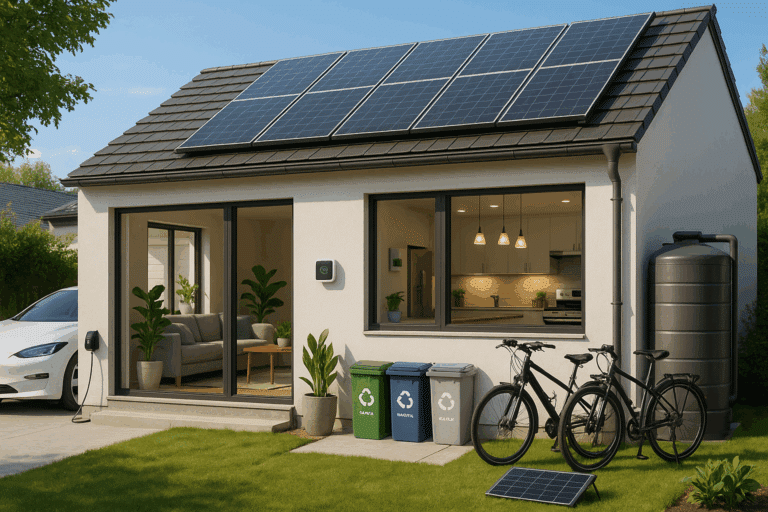However, not everyone can afford or has access to air conditioning, leaving many of us to seek alternative ways to keep cool. This blog post is designed to tackle this very issue, offering innovative, non-AC solutions to help you beat the summer heat at home. 🌞
Before diving into the details, let’s address the big question: Why look for non-AC solutions? First and foremost, energy efficiency. Traditional air conditioning systems can consume a significant amount of electricity, which not only hurts your wallet but also contributes to environmental issues, such as climate change. 🌍
Moreover, the use of air conditioning can cause a range of health problems. For instance, it can dry out the skin and eyes, exacerbate respiratory issues, and in some cases, even lead to conditions like hypothermia. Hence, the need for healthier, more sustainable alternatives.
Exploring Non-AC Solutions: What to Expect?
In this comprehensive guide, we will explore several effective methods to stay cool without relying on air conditioning. From simple behavioral adjustments to implementing sophisticated tech solutions, we will cover a wide range of tactics to make your home more heat-resistant and comfortable. And, even though the subject matter is rather technical, each section will be presented in a clear, comprehensible manner, making the information accessible to everyone – tech-savvy or not. 💡
Firstly, we’ll discuss simple, low-cost behavioral changes you can make. These require little to no investment and can be implemented immediately. Believe it or not, simple adjustments to your daily routines can significantly help to cool your home.🏠
Next, we’ll explore some creative DIY projects to keep your house cool. Don’t worry; these won’t require an engineering degree. Rather, they will be simple, fun, and satisfying projects that can be done with common household items. 🛠️
Following that, we will delve into various tech-based solutions. This includes understanding and utilizing the principles of thermal insulation and heat transfer, exploring energy-efficient appliances, and even discussing smart home technology. 🌐
Last but not least, we’ll take a look at some long-term architectural solutions. While these might require more investment, they can significantly improve the comfort and value of your home in the long run. And yes, we’ll make sure to explain everything in plain English! 👷♀️
So, buckle up for an informative ride. By the end of this post, we promise that you’ll be well-equipped with a variety of strategies to stay cool and comfortable all summer long – without relying on air conditioning. Let’s beat the heat together! 🌡️
🏠 Understanding the Basics: How Heat Transfers in Your Home
When it comes to keeping your home cool without using air conditioning, it’s crucial to understand how heat transfer works. Heat moves in three ways: conduction, convection, and radiation. The more we can minimize these processes, the cooler our homes will stay during those sweltering summer months. Let’s break each of these down:
Conduction is the transfer of heat between two solid objects in direct contact. An example of this is a metal spoon getting hot from stirring a pot of boiling water.
Convection is the transfer of heat through the movement of liquids or gases. This is why we feel warm when a gust of air blows from a heated surface.
Radiation is the transfer of heat in the form of electromagnetic waves. It doesn’t require a medium to move, which is why the sun’s rays can warm the earth.
To illustrate these concepts further, watch “Heat Transfer: Conduction, Convection, and Radiation” by TutorVista (YouTube).
🌤 Harnessing the Power of Nature: Natural Ventilation and Shading
Natural ventilation and shading are two simple yet powerful ways to cool your home without relying on air conditioning. By understanding and using these concepts, you can significantly reduce indoor temperatures and save energy costs.
Natural ventilation works by allowing cooler air to enter the house, while pushing out warmer air. This can be achieved by opening windows and doors, using fans to enhance air movement, and designing the house to facilitate better air flow.
Shading is another essential aspect of natural cooling. By blocking the sun’s rays, shading prevents heat from entering the home, thereby lowering indoor temperatures. Shading can be accomplished through various means, including installing window blinds, using reflective materials, and planting trees around the house.
Check out “Natural Ventilation Principles” by Green Energy Futures (YouTube) to learn more about harnessing the power of nature for cooling your home.
🏗 Embracing Architectural Solutions: Insulation and Cool Roofs
When non-AC cooling solutions are built into the very fabric of your home, you’re well on your way to beating the heat. Two key architectural solutions are insulation and cool roofs.
Insulation works by reducing the amount of heat that enters the home. It does this by providing a barrier between the inside of your home and the outside environment, slowing down the process of conduction. Some popular insulation materials include fiberglass, cellulose, and foam.
Cool roofs are designed to reflect more sunlight and absorb less heat than a standard roof. They can be made from a highly reflective type of paint, a sheet covering, or highly reflective tiles or shingles.
For a deeper dive into these solutions, watch “The Science of Insulation” by Ask This Old House and “Cool Roofs | Department of Energy” by U.S. Department of Energy (YouTube).
🌳 Going Green: Eco-Friendly Solutions to Keep Your Home Cool
Going green isn’t just good for the environment, it’s also good for your wallet. Eco-friendly cooling solutions are not only effective at reducing heat, but they’re also energy-efficient, helping you save on electricity bills.
One of these solutions is using plants for cooling. Plants release moisture into the air through a process called transpiration, which can cool the surrounding environment. Having plants both inside and outside your home can help reduce indoor temperatures.
Another eco-friendly solution is using energy-efficient appliances. These appliances consume less electricity, reducing the amount of heat they produce. They can include everything from energy-efficient light bulbs to refrigerators.
To learn more about these green solutions, watch “How to Use Plants to Keep Your House Cool” by BrightVibes and “Energy Efficient Appliances” by Energy Saver (YouTube).
💻 Smart Home Cooling: Utilizing Technology for a Cooler Home
Technology has made it easier than ever to keep your home cool without an AC. From smart fans to home automation systems, there are numerous tech solutions that can help reduce indoor temperatures.
Smart fans, for instance, can be controlled remotely and can adjust their speed based on the room’s temperature. They can also be programmed to operate at certain times, ensuring optimal cooling when needed.
Home automation systems, on the other hand, can manage various aspects of your home’s environment, including temperature. They can control window blinds, regulate fan speeds, and even manage your home’s insulation and shading systems to keep your home cool.
For a look into how these technologies work, watch “Best Smart Fans of 2021” by TechHive and “How Home Automation Works” by Lifewire (YouTube).

Conclusion
As we come to the end of this comprehensive exploration of DevOps and Agile methodologies in software engineering, it’s essential to take a moment to reflect on the major themes discussed. We’ve tackled a wide range of topics, from the basic principles of Agile and DevOps to the intricate details of their implementation. This is not only a reflection of the depth of these methodologies but also an indication of their critical importance in the current IT landscape. 🎯
Our journey began with a deep dive into the heart of Agile methodology, a process that promotes adaptability, collaboration, and continual improvement. We established that Agile is not merely a strategy but a mindset that encourages iterative development, customer involvement, and a flexible response to change. A link to the Agile Manifesto was provided for readers to gain a thorough understanding of its underlying principles.
We then shifted our focus to DevOps, a practice that fosters a culture of collaboration between development and operations teams. We explained how DevOps breaks down silos, speeds up delivery, and improves product quality, all of which contribute to a more efficient and effective software development lifecycle. Further insights into DevOps can be gleaned from the Amazon Web Services (AWS) page on DevOps.
In the subsequent sections, we elaborated on the practical aspects of Agile and DevOps. We outlined the tools and techniques that can be used to implement these methodologies, including Scrum, Kanban, continuous integration, and continuous deployment. We also pointed out the critical role of automation in achieving the goals of Agile and DevOps.
Throughout this article, we’ve stressed the significance of Agile and DevOps in today’s digital world. They are no longer optional extras but essential components of any successful software development strategy. These methodologies have proven to be effective in meeting the ever-evolving demands of customers and the rapid pace of technological change.
Our hope is that this exploration of Agile and DevOps has been enlightening and inspiring. The depth and breadth of these methodologies can be overwhelming, but their benefits are undeniable. By adopting Agile and DevOps, organizations can enhance their efficiency, adaptability, and customer satisfaction. So why wait? Start your Agile and DevOps journey today! 🚀
We encourage you to share your thoughts and experiences in the comment section below. What challenges have you faced in implementing Agile and DevOps? What benefits have you realized? Your insights could be invaluable to others embarking on this journey.
Moreover, feel free to share this article with colleagues, friends, or anyone who might find it beneficial. Knowledge is power, and the more people who understand and apply Agile and DevOps, the better for our IT community.
To delve deeper into Agile and DevOps, we recommend the following resources:
– Atlassian’s Agile Coach
– IBM’s DevOps page
Thank you for joining us on this journey. Until next time, keep learning, keep evolving, and remember – the future of software development is Agile and DevOps! 🌟
Disclaimer: All the reference links provided in this article are active as of the date of publication.



